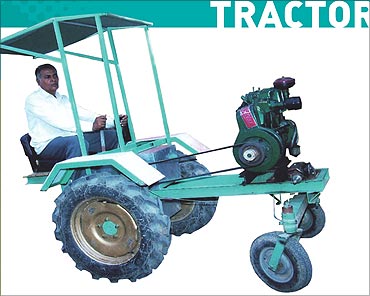 | « Back to article | Print this article |
Why India needs to move beyond jugaad
Innovation is a hot topic and so is India. No wonder then, jugaad has become a hot word too.
From BusinessWeek to Harvard Business Review, Indian innovation is being equated with jugaad (or creative improvisation).
One of us wrote a book recently called From Jugaad to Systematic Innovation emphasising why India has to move away from a jugaad mindset.
Ironically, this book is being used to support the very notion that it questioned. We want to make the case for a move beyond jugaad.
Jugaad is creative and it is improvisation. Three constraints characterise jugaad -- constraints of space, time and resources.
Click NEXT to read on . . .
Why India needs to move beyond jugaad
here is a proximity factor that drives the innovation -- local solution for local problem. There is no major interest in looking at comparative solutions. There is an urgency factor as well -- the here and now.
Remember the day you lost the cover of the beverage bottle you carried? You picked up some plastic sheet and a thread and you managed to create an airtight cover. It worked. It was needed right then.
Finally, there is a scarcity factor. You make do with what you have. Appropriate technology is the word.
Jugaad makes two significant compromises. Functionality rules in jugaad. Aesthetics and efficiency take a backseat in jugaad.
Click NEXT to read on . . .
Why India needs to move beyond jugaad
It is not the best solution that one could arrive at. It is sub-optimal. The point is to satisfy, not to optimise.
In 21st century India, users want products that look and feel good, and will not settle for anything but the best; so both these compromises can knock you out of the reckoning.
Jugaad is wonderful to have. It solves problems in many instances. Every culture across the world has its own ways of creative improvisation.
However, what we are concerned is that for systematic innovation, that is, innovation that can be planned and scaled up, the constraints and compromises of jugaad pose a fundamental problem.
Click NEXT to read on . . .
Why India needs to move beyond jugaad
Proximity, urgency and scarcity are artificial bounds. Great innovations build on a wide array of scientific knowledge and leverage knowledge across several boundaries.
They leverage resources, even externally, if needed. Great innovations take a significant search, that is risky and resource intensive.
They do not take away the need for creative improvisation, but it is just one part of the whole process.
There is a systematic process that needs to be followed at the individual, organisational and environmental levels. Claiming jugaad as the Indian innovation paradigm takes attention away from this multi-faceted challenge.
Click NEXT to read on . . .
Why India needs to move beyond jugaad
The case of Tata Swach exemplifies systematic innovation. TCS' research wing TRDC came up with an innovation for water purifiers using a cheap medium, rice husk -- the stuff that you normally throw away.
An illustrious scientist from IIT Kanpur concluded that the adsorptive properties of rice husk can provide the backbone for a cheap water purifier. The TCS team came up with a quick design, called Sujal, using the husk technology.
Sujal could remove at least 80 per cent of the bacteria -- great by rural standards but fell short of the international standards! When the engineers suggested to market the product as a low-cost innovation, the management refused. It would not have anything less than the best.
Tata Chemicals Limited took up the project. A scientist from TCL came up with the idea of coating rice husk with nanosilver, and the ensuing design surpassed international quality standards.
Click NEXT to read on . . .
Why India needs to move beyond jugaad
With an aesthetically pleasing design, TCL launched the new product, Tata Swach, in 2009 -- a product that has received several international awards.
Another example is Biocon, an entrepreneurial company led by Kiran Mazumdar-Shaw, that has become the flagship firm for the Indian biotechnology industry.
The company had a humble beginning in enzyme manufacturing. It honed its competencies in fermentation technology and applied these well to introduce affordable insulin to India.
A feat in itself as insulin is difficult to synthesise and the global market share is tightly controlled by two large global pharma firms. The unique ability to produce cost-effective insulin is now enabling the company to undertake high-risk research in oral insulin.
Click NEXT to read on . . .
Why India needs to move beyond jugaad
The company is building on the best available knowledge globally. It recently filed an investigative new drug application with the US' Food and Drug Administration.
Is there creativity? Yes. Is there incrementalism? Yes. But systematic innovation goes beyond this. It is taking a calculated risk to attempt to scale new heights, and systematically building capability to mitigate that risk.
The challenge for India is to lay the architecture for systematic innovation. We should be able to bring our science and technology to meet the challenging needs of the society.
Click NEXT to read on . . .
Why India needs to move beyond jugaad
Such an innovative society doesn't emerge purely by improvisation alone. It requires conscious effort by the government, organisations and individuals.
It is great to have a Sujal that can be whipped up quickly. But it should trigger innovations such as Swach. And for that, we need more of a Biocon approach to innovation. That's where India should focus its energy.
Charles Dhanraj is professor and head of Centre for Leadership, Innovation and Change at the Indian School of Business and Rishikesha T Krishnan is professor of corporate strategy & entrepreneurship, Indian Institute of Management-Bangalore.









